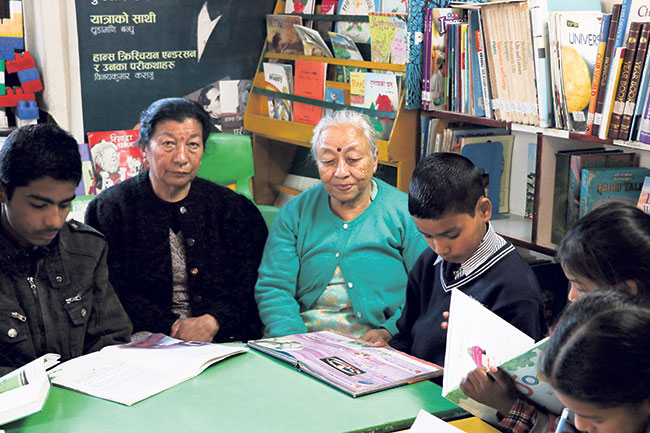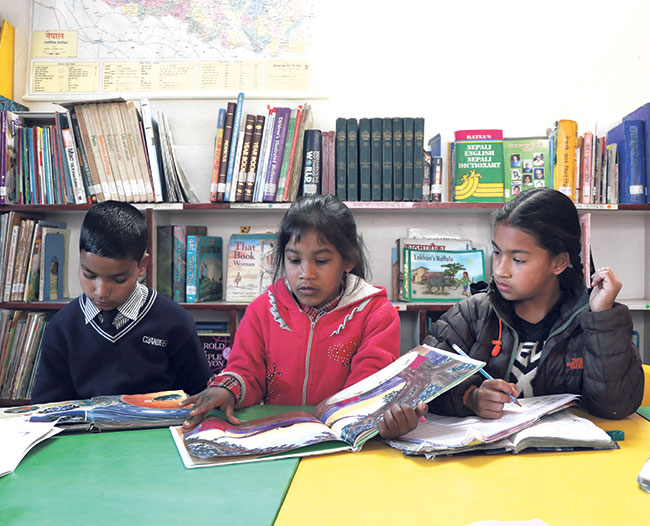KATHMANDU, Feb 12: Unlike the silent and strict periphery that it’s been known for, a library is one of the free spheres where children play, learn and grow at their comfort. Apart from the rot memorizing sessions that they go through in schools, kids require a space to unleash from the daily monotony. Acknowledging the need and importance of kids’ library in Nepal, 68-year-old Indira Dali has been running community child development library at Balkhu for the past eight years now.
Established in 2066 BS with the joint collaboration of eleven members from Nava Jeevan Aama Samuha, the library has been providing free service, especially to the underprivileged children. Installed with more than 3,000 children’s books, it opens six days a week except for Mondays. Being a scholar herself and having earned master’s degrees in Economics, Law, Public Administration and Library and Information Science, the early concept of establishing kids’ library emerged with Dali’s first visit to Japan in 1983.
The case for libraries

A Japanese child being allured by the books in a mobile library pushed her dream of opening a children’s library after her return to Nepal. “As parents or teachers, we impose our wishes upon our children which refrains them from learning what they actually enjoy. Letting them grow in their own space is important for their full-fledged development,” said Dali.
When she started studying and exploring library field after her return, she became familiar with the displeasing scenario of libraries in Nepal. “By now many developments should have been made, but it is disheartening to know that people today are hardly aware of the fact that it takes an entire course such as Library Science to understand the mechanism of running a library,” she added.
 Nepal is one of the countries rich in natural resources, but instead of standing back to its strength after every calamity, people here are left more impoverished. The 2015 mega earthquakes not only destroyed many temples of ancient significance but also severely affected areas of public concern. Government libraries that were collapsed in the calamity are still seeking reconstruction, however as a result a huge number of books are cornered in numerous sacks.
Nepal is one of the countries rich in natural resources, but instead of standing back to its strength after every calamity, people here are left more impoverished. The 2015 mega earthquakes not only destroyed many temples of ancient significance but also severely affected areas of public concern. Government libraries that were collapsed in the calamity are still seeking reconstruction, however as a result a huge number of books are cornered in numerous sacks.
“Sufficient budget allocation is not the only requirement and point of concern here, but proper utilization of the budget is more important,” said Upendra Prasad Mainali, vice-president at Nepal National library. “Land acquisition and building construction is important with addressing the urgent need to promulgate Children Library Act,” he added.
Nevertheless, tiny yet effective approaches have been creating a ripple effect. Organizations and stakeholders have been joining hands to establish and run libraries with their unified efforts. From reading and social interaction to personality development and cognitive growth, a library enhances the children’s ability to acknowledge their priorities at an early age. “At Read Nepal we have been organizing interactive session for children and their grandparents. One of which is ‘Hajurba Hajuraama Ko Katha Mero Chitra’ where grandparents dictate the story to their four-eight year old grandchildren with pictures to draw as per the direction of their grandparents. With the session, we have so far succeeded in publishing a dozen of books,” said Bhola Shrestha, president at Read Nepal, Baluwatar and Chief Librarian at Dilliraman-Kalyani Regmi Memorial Library, Lazimpat. “The recent project that we started is called ‘One Thousand Books for Children’ where we give away presents to the children of Read Nepal who have read a maximum number of books of any type,” added Shrestha.
 A repository of knowledge, library is the fossil of human civilization that witnesses, records and reflects the timeline of written innovations. It is only through the power of reading that we can traverse to centuries-old events.
A repository of knowledge, library is the fossil of human civilization that witnesses, records and reflects the timeline of written innovations. It is only through the power of reading that we can traverse to centuries-old events.









































